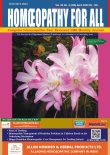Food Allergy and its Homoeopathic Management
Keywords:
Viennese paediatrician, Risk factorsAbstract
Viennese paediatrician Clemens von Pirquet was the first originally presented concept of allergy in 1906, when he observed that patients who had received injections of horse serum or smallpox vaccine usually had quicker, more severe reactions to second injections.1The word allergy is originated from Greek word allos meaning “other” and ergon meaning “work”.2Numbers of food allergiesare soaring gradually in worldwide and Asian countries but it is still relatively lower in Asian countries than in urbanized Western populations.3Ample data are lacking in India to estimate the prevalence of Allergy. Food allergy is the immune system’s reaction to any harmless food materials. It is estimated that food allergies affects 6% of children and 4 % of adults.4In India, from last 40 years,increase in allergic disease from 10%to 30% has been reported.5,6These diseases include hay fever, food allergies, atopic dermatitis, allergic asthma, and anaphylaxis.7Food allergy can have negative effects on the quality of life of patients and their families. Accidental exposure may happen any time hence they have remain vigilant every time. Symptoms of allergic reaction can be visible from gastrointestinal symptoms or skin rashes to severe reactions that can be fatal to children and adults.8Conventional system of medicine use to prescribe immunosuppressant as the treatment guideline for the allergic patient. In this article, we will discuss about the allergy and its homoeopathic management.
Downloads
References
Clemens Peter Pirquet von Cesenatico at Who Named It? https://en.wikipedia.org/wiki/ Allergy#cite_note-127
Von Pirquet C (1906). “Allergie”. Munch Med Wochenschr. 53 (5): 388–90. PMID 20273584. Reprinted in Von Pirquet C (1946). “Allergie”. Annals of Allergy.
(5): 388–90. PMID 20273584.
Lee AJ, Thalayasingam M, Lee WB: Food allergy in Asia: how does it compare? Asia Pac Allergy 2013; 3: 3–14.
Boye JI: Food allergies in developing and emerging economies: need for comprehensive data on prevalence rates. ClinTransl Al lergy 2012; 2:25.
Vishwananthan R. Definition, incidence, aetiology and natural history of asthma. Ind J Chest Dis 1964; 6:108-24.
Singh AB, Kumar P. Aeroallergens in clinical practice of allergy in India. An overview. Ann Agric Environ Med 2003; 10: 131–36.
“Types of Allergic Diseases”. NIAID. 29 May 2015. Archived from the original on 17 June 2015. Retrieved 17 June 2015.
Food Allergy, NIAID Office of Communications and Government Relations 5601 Fishers Lane, MSC 9806 Bethesda, MD 20892-9806 (deliveries: Rockville, MD 20852) United States of America. https:// www.niaid.nih.gov/global/ contact-us
Liu AH, Jaramillo R, Sicherer SH, WoodRA, Bock SA, Burks AW et al. National prevalence and risk factors for food allergy and relationship to asthma: results from the National Health and Nutrition Examination Survey 2005–2006.J Allergy ClinImmunol 2010;126:798– 806
Mahesh, P.A.; Wong, G.W.; Ogorodova, L.; Potts, J.; Leung, T.F.; Fedorova, O.; Holla, A.D.; Fernandez-Rivas, M.; Clare Mills, E.N.; Kummeling, I.; et al. Prevalence of food sensitization
and probable food allergy among adults in India: The EuroPrevall INCO study. Allergy 2016, 71, 1010–1019.
Sicherer, S.H.; Sampson, H.A. Food allergy: A review and update on epidemiology, pathogenesis, diagnosis, prevention and management. J. Allergy Clin. Immunol. 2018, 141, 41–58.
Du Toit, G.; Tsakok, T.; Lack, S.; Lack, G. Prevention of food allergy. J. Allergy Clin. Immunol. 2016, 137,998–1010.
Dey, Debarati; Ghosh, Nandini; Pandey, Naren; Gupta Bhattacharya, Swati (2014). A Hospital-Based Survey on Food Allergy in the Population of Kolkata, India. International Archives of Allergy and Immunology, 164(3), 218–221. doi:10.1159/000365629
Rossi E., Picchi M., Bartoli P., Panozzo M., Cervino C., Nurra L. Homeopathic therapy in pediatric atopic diseases: short and long-term results. Homeopathy, Volume 105, 2016.
Sharma S., Naura A.S. Potential of phytochemicals as immune-regulatory compounds in atopic diseases: A review. Biochemical Pharmacology, Volume 173, 2020.
J. H. Clarke, Dictionary of Practical Materia Medica, Reprint Edition 1992, B. Jain Publishers, New Delhi.
F. Schroyens, Synthesis Treasure Edition 2009V, RadarOpus 1.33 (Homoeopathic Software), Archibel S.A. Rue Fontaine St. Pierre 1E, Zoning Industriel de la Fagne, 5330 Assesse, Belgium18Hering’s guiding symptoms of our Materia Medica By Calvin B. Knerr, M. D. B Jain Publishers Pvt Ltd; New Delhi
Dr. P. N. Varma, KusumYadav,
Ramachandran Valavan, A Compendium of Rare and Clinically Established Mother Tinctures, 4th Edition, Dr. Willmar Schwabe India Pvt. Ltd., A-36, Sector 60, Noida.
W. Boericke, New Manual of Homoeopathic Materia Medica & Repertory [with Relationship of Remedies], Second Re Augmented & Revised Edition Based on Ninth Edition, Reprint Edition 2002, B. Jain Publishers, New Delhi.




